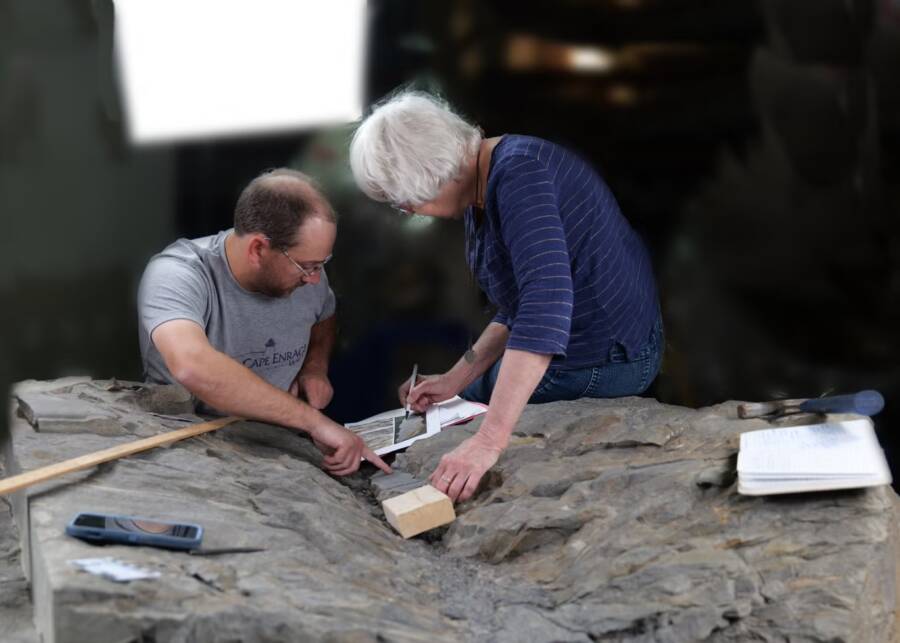"It's a very Dr. Seuss-looking tree."

Tim StonesiferA model of Sanfordiacaulis densifolia.
Researchers recently discovered fossils of a prehistoric tree “unlike any of those that live at the present” in New Brunswick, Canada.
This ancient, alien-like tree was given the name Sanfordiacaulis densifolia in a new study published in the scientific journal Current Biology.
The Discovery Of ‘Sanfordiacaulis Densifolia’
Two co-authors of the study, Olivia King and Matthew Stimson, unearthed the first Sanfordiacaulis densifolia fossil in a New Brunswick quarry in 2017, and in the years since, scientists have discovered four more. One of the specimens in particular is so well-preserved that experts have been able to reconstruct what the tree once looked like.
With a long, narrow trunk and a crown of leaves that may have been up to 18 feet in diameter, Sanfordiacaulis densifolia was so top-heavy it likely had to intertwine its branches with other nearby trees to stay upright. It grew below the canopy of taller trees surrounding it and stretched so wide in order to soak up as much sunlight filtering through the leaves above as possible.
“When my co-authors and I began to reconstruct the tree based on the specimens collected in Sanford quarry, the only analog we could think of was an oversized toilet or bottle brush,” the study’s lead author, Robert Gastaldo of Colby College, told All That’s Interesting via email.
“If you were to hold a bottle brush with the bristles up, increase the diameter of the stick to only six inches or so, and lengthen the scale of each bristle to where their ends extended nearly nine feet in each direction around it, that’s a good approximation of how strange and unique Sanfordiacaulis is.”
King likewise noted that it looked like “one of those truffula trees from The Lorax.”
As Gastaldo explains, he and his colleagues estimate that the Sanfordiacaulis densifolia had more than 250 leaves. In the fossilized specimens they studied, the leaves extended about six feet from the trunk, but they likely grew even longer.

Alan GrahamResearchers investigating the prehistoric Sanfordiacaulis densifolia fossil.
“To find a tree trunk around which more than 250 leaves are still attached, spirally arranged, and compressed into less than one meter (39 inches) of trunk length is unheard of,” Gastaldo said. “It’s overall appearance might make you think it’s tree fern or palm-like, but the oldest fossil tree fern is younger than our plant, and the oldest palm isn’t found in the fossil record for another 240 million years.”
The spectacular preservation seen in the fossils is due to an earthquake that occurred about 350 million years ago. The quake caused the bank on which the plants stood to collapse into a lake, and the trees were immediately covered in mud and silt. Because of this rapid preservation while the foliage was still alive, the Sanfordiacaulis densifolia fossils are uniquely three-dimensional
An ‘Unsuccessful Experiment’ In Plant Biology
One of the fossils includes both the trunk and crown of a Sanfordiacaulis densifolia, a rare occurrence that, when paired with the 3D nature of the tree’s remains, is allowing scientists to get a closer look at history than ever before.
“As most folks know, plant parts decay over very short periods of time. In the case of leaves, this can be as short as a few days to a few weeks. In the case of non-woody trunks, complete decay can occur in weeks to a few months depending on a number of factors,” Gastaldo said.
“There are only a handful of fossil trees discovered where leaves remain attached to the trunk, and even fewer examples where the crown of the tree is conserved in the fossil record. Sanfordiacaulis is one of only a very small number of such examples.”

Tim StonesiferThe height of Sanfordiacaulis densifolia compared to the average human.
Sanfordiacaulis densifolia presents some of the earliest evidence of a smaller tree growing beneath a taller forest canopy, the researchers said. This evidence shows that life in the Early Carboniferous period was much more complex than previously believed and that the tree evolved during a time when plants were “experimenting” with various forms.
Most of what researchers know about this transitionary period in Earth’s history comes from fossil plants which had grown in wetlands along coastal zones. As a result, Gastaldo said, many of these plants have “a familiar look to them.”
But because Sanfordiacaulis grew away from the coast, on the ancient continent’s interior soils, it is far more unique than previous plant fossils.
The professor added that the discovery shows researchers just how many different “unimagined and evolutionary experiments” there were in the history of the evolution of trees.
“Its discovery shows that ‘Mother Nature’ explored any number of unique solutions for growing on land and it is likely that we will never know the full extent of deep time biodiversity because it is extremely rare to find fossils as complete as Sanfordiacaulis,” Gastaldo said.
That said, the discovery of this “Dr. Seuss-looking tree” offers fascinating insight into the history of life on planet Earth.
After reading about the discovery of this prehistoric tree fossil, learn about the Methuselah tree — the oldest tree in the world. Or, read about the manchineel tree, the world’s deadliest tree.





